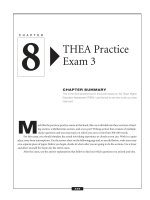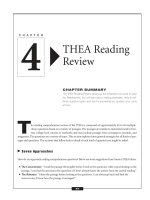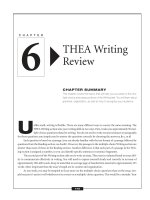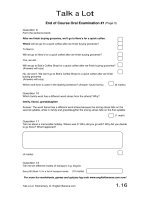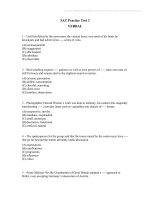Thea writting review 3 pptx
Bạn đang xem bản rút gọn của tài liệu. Xem và tải ngay bản đầy đủ của tài liệu tại đây (62.96 KB, 6 trang )
Section 1: Reading
Questions 1–6 are based on the following passage.
The following is taken from a case that came before the
Supreme Court in 1954: “347 US 483 (1954) Brown v.
Board of Education.”
(1) These cases come to us from the States of Kansas,
South Carolina, Virginia, and Delaware. . . . Argu-
ment was heard in the 1952 Term and reargument
was heard this Term on certain questions pro-
pounded by the Court.
(2) Reargument was largely devoted to the cir-
cumstances surrounding the adoption of the 14th
Amendment in 1868. It covered exhaustively con-
sideration of the Amendment in Congress, ratifica-
tion by the states, then existing practices in racial
segregation, and the views of proponents and oppo-
nents of the Amendment. These sources and our
own investigation convince us that, although these
sources cast some light, it is not enough to resolve
the problem with which we are faced. At best, they
are inconclusive. The most avid proponents of the
post-War Amendments undoubtedly intended them
to remove all legal distinctions among “all persons
born or naturalized in the United States.” Their
opponents, just as certainly, were antagonistic to
both the letter and the spirit of the Amendments and
wished them to have the most limited effect. What
others in Congress and the state legislatures had in
mind cannot be determined with any degree of
certainty.
(3) An additional reason for the inconclusive
nature of the Amendment’s history, with respect to
segregated schools, is the status of public education
at that time. In the South, the movement toward free
common schools, supported by general taxation,
had not yet taken hold Even in the North, the
conditions of public education did not approximate
those existing today. The curriculum was usually
rudimentary; ungraded schools were common in
rural areas; compulsory school attendance was vir-
tually unknown. As a consequence, it is not surpris-
ing that there should be so little in the history of the
14th Amendment relating to its intended effect on
public education
(4) In approaching this problem, we cannot
turn the clock back to 1868, when the [14th]
Amendment was adopted We must consider
public education in the light of its full development
and its present place in American life throughout the
Nation Today,education is perhaps the most
important function of state and local governments.
Compulsory school attendance laws and the great
expenditures for education both demonstrate our
recognition of the importance of education to our
democratic society. It is required in the performance
of our most basic public responsibilities, even serv-
ice in the armed forces. It is the very foundation of
good citizenship. Today it is a principal instrument
in awakening the child to cultural values, in prepar-
ing him for later professional training, and in help-
ing him to adjust normally to his environment. In
these days, it is doubtful that any child may reason-
ably be expected to succeed in life if he is denied the
opportunity of an education. Such an opportunity,
where the state has undertaken to provide it, is a
right which must be made available to all on equal
terms
(5) We conclude that in the field of public edu-
cation . . . [s]eparate educational facilities are inher-
ently unequal. Therefore, we hold that the plaintiffs
and others similarly situated for whom the actions
have been brought are deprived ofequal
protection.
– THEA PRACTICE EXAM 2–
201
1. The passage indicates that the plaintiffs referred
to in paragraph 5 were
a. not represented by attorneys.
b. public school students.
c. school board members.
d. public school teachers.
2. In paragraph 2, the phrase post-War Amendments
refers to
a. Constitutional amendments dealing with
education.
b. the Bill of Rights.
c. Constitutional amendments dealing with the
military.
d. the 14th and other Constitutional amend-
ments adopted after the Civil War.
3. Use of the term reargument in paragraphs 1 and
2 would indicate that
a. on occasion, the U.S. Supreme Court hears
arguments on the same case more than once.
b. the plaintiffs were not adequately prepared the
first time they argued.
c. one or more Justices was absent during the
first argument.
d. the membership of the Supreme Court
changed after the first argument.
4. According to paragraph 3 of the passage, the
Court determined that it is not clear what impact
Congress intended the 14th Amendment to have
on public education because
a. Congress generally does not deal with public
education.
b. public education was not universally available
or standardized at the time.
c. in 1868, no transcripts of Congressional
debates were kept.
d. the Court disagreed with Congress’ intentions.
5. Which of the following sets of topics would best
organize the information in the passage?
a. I. the Supreme Court’s role in public
education
II. the role of state government in public
education
b. I. the history of the 14th Amendment
II. the cost of public education
c. I. the 14th Amendment and public
education
II. the importance of public education for
individuals and the country
d. I. the role of Congress in funding public
education
II. the evolution of public education
6. At the time of the adoption of the 14th Amend-
ment, little attention was paid to the subject of
mandatory school attendance. According to
paragraph 3 of the passage, this was because, at
that time, mandatory attendance was
a. impossible to enforce.
b. enforced unequally with regard to race.
c. practically non-existent.
d. supported only by public taxation.
Questions 7–12 are based on the following passage.
(1) A recent government report addressing concerns
about the many implications of genetic testing out-
lined policy guidelines and legislative recommen-
dations intended to avoid involuntary and ineffective
testing and to protect confidentiality.
(2) The report identified urgent concerns, such
as quality control measures (including federal over-
sight for testing laboratories) and better genetics
training for medical practitioners. It recommended
voluntary screening; urged couples in high-risk pop-
ulations to consider carrier screening; and advised
– THEA PRACTICE EXAM 2–
202
caution in using and interpreting pre-symptomatic
or predictive tests as certain information could eas-
ily be misused or misinterpreted.
(3) About three in every 100 children are born
with a severe disorder presumed to be genetic or
partially genetic in origin. Genes, often in concert
with environmental factors, are being linked to the
causes of many common adult diseases such as coro-
nary artery disease, hypertension, various cancers,
diabetes, and Alzheimer’s disease. Tests to deter-
mine predisposition to a variety of conditions are
under study, and some are beginning to be applied.
(4) The report recommended that all screen-
ing, including screening of newborns, be voluntary.
Citing results of two different voluntary newborn
screening programs, the report said these programs
can achieve compliance rates equal to or better than
those of mandatory programs. State health depart-
ments could eventually mandate the offering of tests
for diagnosing treatable conditions in newborns;
however, careful pilot studies for conditions diag-
nosable at birth need to be done first.
(5) Although the report asserted that it would
prefer that all screening be voluntary, it did note
that if a state requires newborn screening for a par-
ticular condition, the state should do so only if there
is strong evidence that a newborn would benefit
from effective treatment at the earliest possible age.
Newborn screening is the most common type of
genetic screening today. More than four million
newborns are tested annually so that effective treat-
ment can be started in a few hundred infants.
(6) Prenatal testing can pose the most difficult
issues. The ability to diagnose genetic disorders in
the fetus far exceeds any ability to treat or cure them.
Parents must be fully informed about risks and ben-
efits of testing procedures, the nature and variabil-
ity of the disorders they would disclose, and the
options available if test results are positive.
(7) Obtaining informed consent—a process
that would include educating participants, not just
processing documents—would enhance voluntary
participation. When offered testing, parents should
receive comprehensive counseling, which should
be nondirective. Relevant medical advice, however,
is recommended for treatable or preventable
conditions.
(8) Genetics also can predict whether certain
diseases might develop later in life. For single-gene
diseases, population screening should only be con-
sidered for treatable or preventable conditions of
relatively high frequency. Children should be tested
only for disorders for which effective treatments or
preventive measures could be applied early in life.
7. The word predisposition, as it is used in the pas-
sage, most nearly means
a. willingness.
b. susceptibility.
c. impartiality.
d. composure.
8. The report stressed the need for caution in the
use and interpretation of
a. predictive tests.
b. newborn screening.
c. informed consent.
d. pilot studies.
9. According to the passage, how many infants are
treated for genetic disorders as a result of new-
born screening?
a. dozens
b. hundreds
c. thousands
d. millions
– THEA PRACTICE EXAM 2–
203
10. One intention of the policy guidelines was to
a. implement compulsory testing.
b. minimize concerns about quality control.
c. endorse the expansion of screening programs.
d. preserve privacy in testing.
11. According to the report, states should implement
mandatory infant screening only
a. if the compliance rate for voluntary screening
is low.
b. for mothers who are at high risk for genetic
disease.
c. after meticulous research is undertaken.
d. to avoid the abuse of sensitive information.
12. The most prevalent form of genetic testing is
conducted
a. on high-risk populations.
b. on adults.
c. on fetuses prior to birth.
d. on infants shortly after birth.
Questions 13–17 are based on the following passage.
(1) If you have ever made a list of pros and cons to
help you make a decision, you have used the utili-
tarian method of moral reasoning. One of the main
ethical theories, utilitarianism posits that the key to
deciding what makes an act morally right or wrong
is its consequences. Whether our intentions are good
or bad is irrelevant; what matters is whether the
result of our actions is good or bad. To utilitarians,
happiness is the ultimate goal of human beings and
the highest moral good. Thus, if there is great
unhappiness because of an act, then that action can
be said to be morally wrong. If, on the other hand,
there is great happiness because of an action, then
that act can be said to be morally right.
(2) Utilitarians believe that we should care-
fully weigh the potential consequences of an action
before we take it. Will the act lead to things that will
make us, or others, happy? Will it make us, or oth-
ers, unhappy? According to utilitarians, we should
choose to do that which creates the greatest amount
of good (happiness) for the greatest number of peo-
ple. This can be difficult to determine, though,
because sometimes an act can create short-term
happiness but misery in the long term. Another
problematic aspect of utilitarianism is that it deems
it acceptable—indeed, even necessary—to use
another person as a means to an end and sacrifice the
happiness of one or a few for the happiness of many.
13. In the first sentence, the author refers to a list of
pros and cons in order to
a. show that there are both positive and negative
aspects of utilitarianism.
b. suggest that making a list of pros and cons is
not an effective way to make a decision.
c. emphasize that utilitarians consider both the
good and the bad before making a decision.
d. show readers that they are probably already
familiar with the principles of utilitarian
reasoning.
14. The word posits in the second sentence means
a. agrees.
b. asserts.
c. places.
d. chooses.
15. According to the definition of utilitarianism in
paragraph 1, stealing bread to feed hungry chil-
dren would be
a. morally right because it has good intentions.
b. morally wrong because it violates the rights of
another.
c. morally right because it has positive
consequences.
d. morally wrong because stealing is illegal.
– THEA PRACTICE EXAM 2–
204
16. According to the utilitarian principles described
in paragraph 2, we should
a. do what will bring us the most happiness.
b. always think of others first.
c. make our intentions clear to others.
d. do what will make the most people the most
happy.
17. In the last sentence, the author’s purpose is to
show that
a. using utilitarianism to make a moral decision
is not always easy.
b. sacrifice is necessary in life.
c. long-term consequences are more important
than short-term consequences.
d. a pro/con list is the most effective technique
for making an important decision.
Questions 18–22 are based on the following passage.
(1) Jazz, from its early roots in slave spirituals and
the marching bands of New Orleans, had developed
into the predominant American musical style by
the 1930s. In this era, jazz musicians played a lush,
orchestrated style known as swing. Played in large
ensembles, also called big bands, swing filled the
dance halls and nightclubs. Jazz, once considered
risqué, was made more accessible to the masses with
the vibrant, swinging sounds of these big bands.
Then came bebop. In the mid-1940s, jazz musicians
strayed from the swing style and developed a more
improvisational method of playing known as bebop.
Jazz was transformed from popular music to an elite
art form.
(2) The soloists in the big bands improvised
from the melody. The young musicians who ushered
in bebop, notably trumpeter Dizzy Gillespie and
saxophonist Charlie Parker, expanded on the
improvisational elements of the big bands. They
played with advanced harmonies, changed chord
structures, and made chord substitutions. These
young musicians got their starts with the leading big
bands of the day, but during World War II—as older
musicians were drafted and dance halls made cut-
backs—they started to play together in smaller
groups.
(3) These pared-down bands helped foster the
bebop style. Rhythm is the distinguishing feature of
bebop, and in small groups the drums became more
prominent. Setting a driving beat, the drummer
interacted with the bass, piano, and the soloists, and
together the musicians created fast, complex
melodies. Jazz aficionados flocked to such clubs as
Minton’s Playhouse in Harlem to soak in the new
style. For the young musicians and their fans this was
a thrilling turning point in jazz history. However, for
the majority of Americans, who just wanted some
swinging music to dance to, the advent of bebop was
the end of jazz as mainstream music.
18. The swing style can be most accurately character-
ized as
a. complex and inaccessible.
b. appealing to an elite audience.
c. lively and melodic.
d. lacking in improvisation.
19. According to the passage, in the 1940s you would
most likely find bebop being played where?
a. church
b. a large concert hall
c. in music schools
d. small clubs
– THEA PRACTICE EXAM 2–
205

